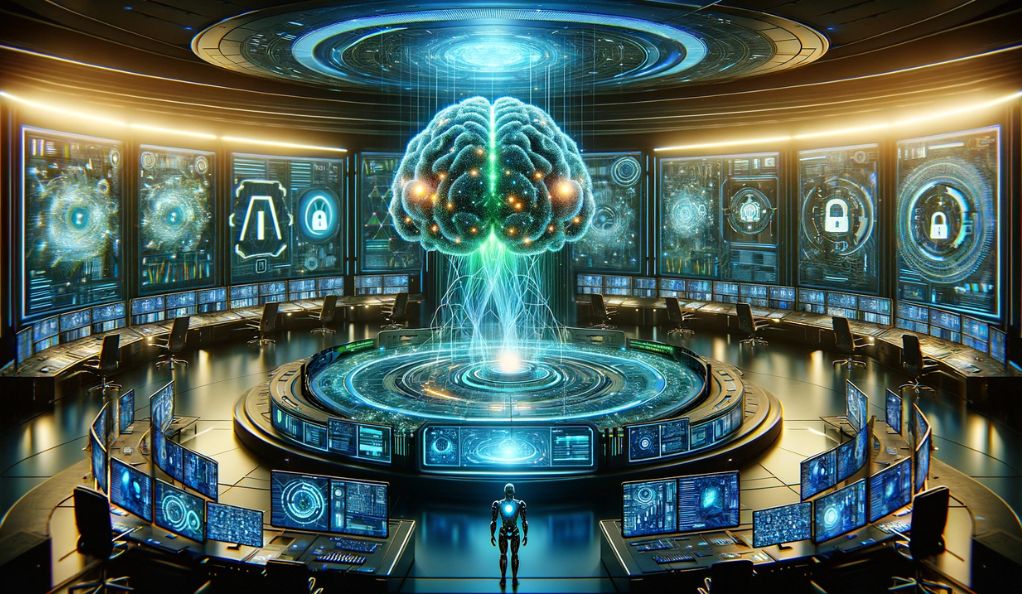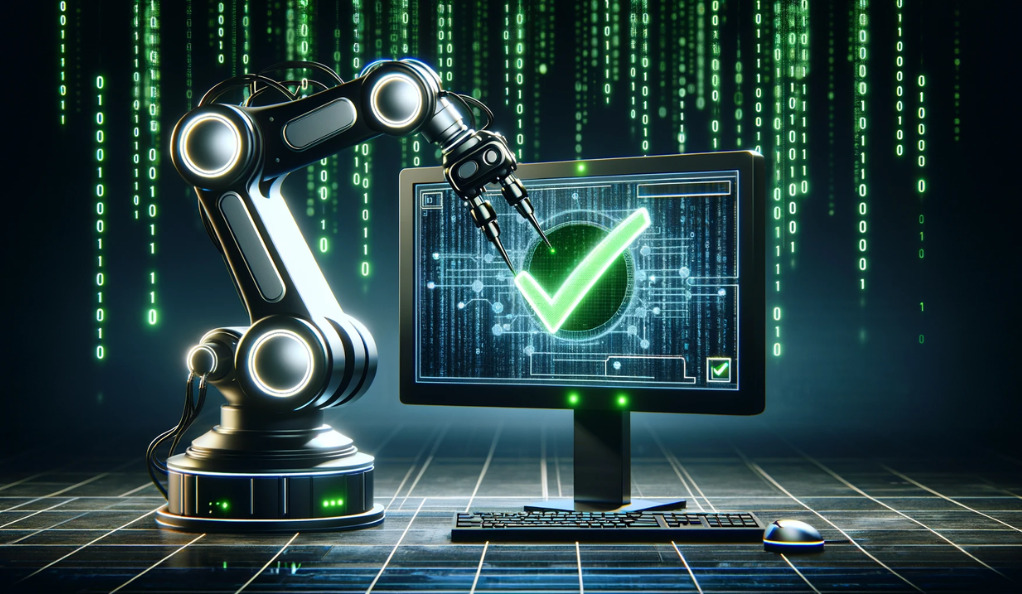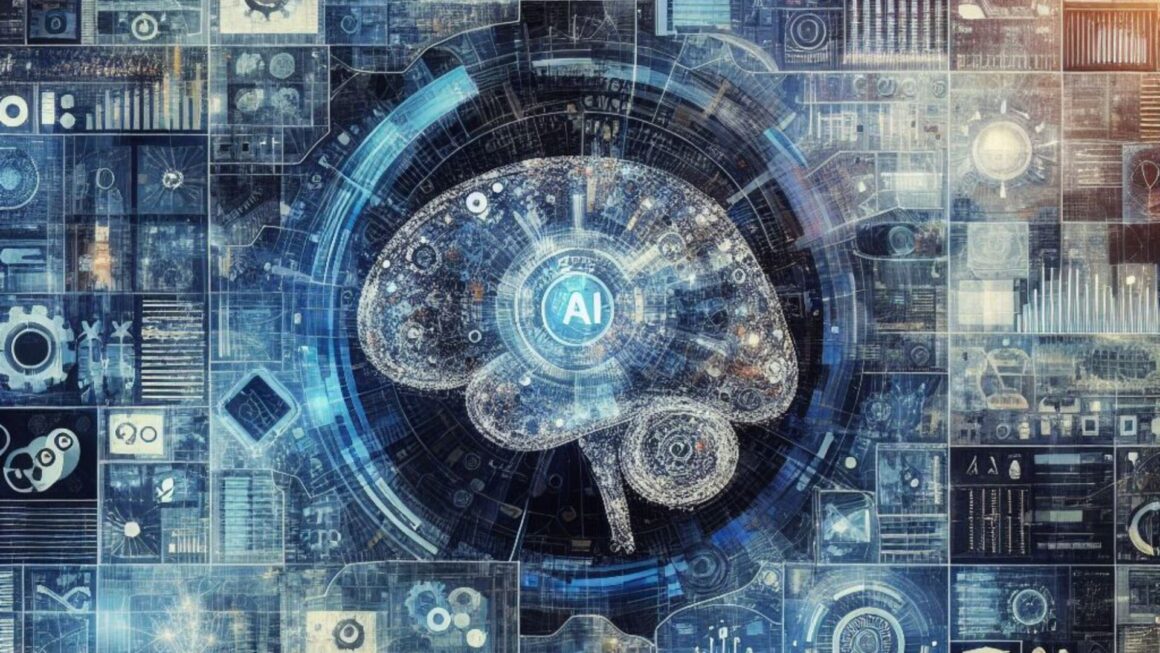In the epoch of the Fourth Industrial Revolution, artificial intelligence (AI) has emerged as a cornerstone technology, pivotal not only in driving innovation but also in safeguarding the vast expanse of Internet-connected systems. Its integration into cybersecurity heralds a transformative era where protection against cyber threats is not just reactive, but also proactive and predictive.
AI’s application in cybersecurity is a response to the increasingly sophisticated landscape of cyber threats. Cyber adversaries continuously evolve, leveraging new techniques and strategies to bypass traditional security measures. Here, AI steps in as a dynamic ally. Through its capability to analyze vast quantities of data at speeds and accuracies unmatchable by humans, AI systems can detect patterns and anomalies that may signify a security breach or an impending threat.
The essence of AI in cybersecurity lies in its learning algorithms. Machine Learning (ML) and Deep Learning (DL) techniques enable these systems to learn from past data, improve upon their detection capabilities, and adapt to new, previously unseen forms of cyberattacks. This learning process is continuous, ensuring that the AI models refine their predictive accuracy over time.
The deployment of AI in cybersecurity manifests in various forms:
- Threat Detection: AI systems can sift through data traffic to identify unusual patterns that may indicate a security threat.
- Phishing Detection: By analyzing the text and images used in emails, AI can flag potential phishing attempts.
- Fraud Prevention: AI can predict and prevent fraudulent activities by recognizing suspicious behavior patterns.
- Network Security: AI algorithms can monitor network traffic in real-time to detect and respond to anomalies swiftly.
By integrating AI, cybersecurity strategies are not just bolstered; they are revolutionized. The approach shifts from a traditional perimeter-based defense to a more robust, intelligent system that is not bounded by the limitations of human oversight. It’s a paradigm where cybersecurity systems learn, evolve, and autonomously react to emerging threats.

As cyber threats grow in complexity and subtlety, the need for AI-driven cybersecurity becomes not just beneficial but essential. It represents a proactive stance, preempting attacks before they can cause harm. This integration is not just about upgrading existing systems but about rethinking the very fabric of cybersecurity to make it more resilient and intelligent.
The transition to AI-driven cybersecurity is not without its challenges. It requires a foundational understanding of AI technologies, a strategic approach to integration, and a continuous effort in training and updating the AI models. However, the benefits—enhanced detection capabilities, reduced response times, and improved overall security posture—make it an indispensable tool in the modern cybersecurity arsenal.
Understanding AI-Driven Security Testing Platforms
The inception of AI-driven security testing platforms marks a significant milestone in the evolution of cybersecurity practices. These platforms employ a combination of advanced AI techniques, including machine learning and deep learning, to simulate a wide array of cyberattacks, identify vulnerabilities, and suggest remediations. Such platforms are not mere tools; they are sophisticated allies that enhance the capabilities of security teams.
AI Security Risk Assessment Frameworks
A critical aspect of these platforms is their ability to assess and manage security risks intelligently. Organizations have started to implement structured AI security risk assessment frameworks that allow for a comprehensive evaluation of AI systems. These frameworks serve as blueprints for auditing, tracking, and improving the security posture of AI systems. They encompass various components:
- Asset Inventory: Cataloging all AI assets within the organization.
- Threat Modeling: Identifying potential threats specific to AI systems.
- Vulnerability Analysis: Analyzing and prioritizing potential vulnerabilities.
- Risk Evaluation: Assessing the likelihood and impact of identified risks.
Through these frameworks, organizations can not only identify but also anticipate potential security breaches, allowing them to take preemptive measures.
Advancements in AI Security Testing Tools
The next generation of Static Application Security Testing (SAST) tools is now leveraging AI to scale the capabilities of security teams. By incorporating machine learning algorithms, these tools can analyze code more efficiently and accurately than ever before. They can understand the context within which the code operates, making it possible to spot complex vulnerabilities that would be difficult to detect using conventional methods.
AI-driven security testing tools bring several advancements to the table:
- Automated Code Review: AI tools can scan through thousands of lines of code, identifying potential security issues quickly.
- Behavioral Analysis: Beyond static code, AI can monitor applications in runtime, observing behavior to detect anomalies that may indicate a breach.
- Customized Testing: Based on past data, AI can customize its testing approach for each application, focusing on areas with a higher risk profile.
By harnessing these tools, security teams can extend their reach, covering more ground with greater precision. This is not about replacing the human element but about amplifying human expertise, enabling security professionals to focus on more strategic tasks while AI handles the repetitive, time-consuming aspects of security testing.
The emergence of AI-driven security testing platforms represents a significant leap forward in our ability to defend against cyber threats. As these platforms continue to mature, they promise to become an integral part of the cybersecurity infrastructure, offering a more proactive and intelligent defense mechanism against the ever-evolving landscape of cyber threats.
The Importance of Penetration Testing in AI
Penetration testing, or pen testing, has traditionally been the linchpin of proactive cybersecurity. It involves simulating cyberattacks to identify and rectify security vulnerabilities. However, with the integration of AI, pen testing has transcended its conventional boundaries, becoming more sophisticated and precise.
AI-driven pen testing tools are designed to emulate the behaviors of both attackers and defenders, using advanced algorithms to conduct comprehensive testing at a pace and level of complexity that is humanly unattainable. These tools can perform tasks ranging from scanning networks for vulnerabilities to executing complex attack sequences to test the resilience of systems. The benefits they offer are multifold:
- Speed and Efficiency: AI tools can execute multiple testing sequences simultaneously, significantly reducing the time required to conduct thorough pen tests.
- Accuracy and Depth: With the ability to learn from each test, AI-driven tools can uncover deep-seated vulnerabilities that might escape human testers.
- Continuous Learning: As AI tools are exposed to new environments and threats, they adapt, enhancing their testing capabilities and ensuring that security measures are robust against the latest threats.
Administrators and security teams utilize these AI capabilities to augment their efforts. By automating the repetitive and labor-intensive parts of pen testing, security professionals can allocate their time to interpreting the results and strategizing on more complex security challenges. This human-AI partnership is pivotal for a resilient cybersecurity defense.
AI’s role in pen testing is not just about automating existing processes but about redefining the scope and potential of security testing. AI-driven cybersecurity teams are a perfect embodiment of human augmentation. They leverage AI to enhance human capabilities, leading to a more dynamic and responsive security posture.
The strategic use of AI in pen testing represents a significant shift from a purely labor-intensive process to a more intelligence-led approach. It’s about using technology to its full potential to ensure that cybersecurity defenses are as dynamic and adaptable as the threats they aim to counter. As AI technology continues to evolve, so too will the capabilities of pen testers, making AI-driven pen testing an indispensable element of modern cybersecurity strategies.
Machine Learning: The New Frontier in Security Testing

Machine learning (ML) has redefined the boundaries of what is possible in security testing. Where traditional security systems may struggle to keep pace with the rapid evolution of cyber threats, ML thrives on this constant change, using it as fodder for its ever-improving models. The application of ML in security testing has proven to be a formidable force against cyber threats, providing insights and automation that were previously unattainable.
Application of Machine Learning in Security Testing
The core advantage of ML lies in its ability to process and learn from data at an extraordinary scale. This capability allows security platforms to analyze patterns across countless cyber incidents, helping to identify potential threats before they manifest into breaches. ML models can be trained on historical data to recognize the signs of specific attack vectors, such as malware or ransomware, and can even predict new ones through anomaly detection techniques.
Enhancing Detection with ML Algorithms
One of the most significant contributions of ML in security testing is its enhancement of detection capabilities. ML algorithms excel at uncovering subtle, complex patterns that are indicative of sophisticated cyberattacks. They can:
- Sift through massive datasets to identify anomalies.
- Recognize the digital ‘fingerprints’ of hackers.
- Adapt to new and emerging threats more quickly than static, rule-based systems.
Challenges and Considerations
However, the integration of ML into security testing is not without its challenges. The quality of ML models is highly dependent on the quality of the data they are trained on. Moreover, ML systems themselves can become targets for attackers, necessitating robust security measures to protect the ML models. Organizations must approach the adoption of ML with a clear strategy, understanding the technology’s capabilities and limitations.
The inclusion of ML in security testing platforms represents a paradigm shift, equipping cybersecurity professionals with tools that are not only reactive but also predictive. As ML continues to advance, it will play an increasingly central role in the fight against cybercrime, offering a level of agility and intelligence that keeps security one step ahead of the threat.
Vulnerability Assessment with AI: A Game Changer
Vulnerability Assessment and Penetration Testing (VAPT) are critical components of any robust cybersecurity strategy. The integration of AI into VAPT processes is transforming the field, making it not only more efficient but also significantly more effective. This transformation is leading to a seismic shift in the cybersecurity landscape, as AI-driven VAPT becomes a standard.
AI-driven VAPT: An Overview
AI-driven VAPT tools use machine learning algorithms to scan systems for vulnerabilities, analyze the risks associated with those vulnerabilities, and simulate attack patterns to test defenses. These tools are constantly learning from new data, which allows them to identify vulnerabilities that a human might miss. They also enable organizations to assess their security posture in real-time and predict the effectiveness of their defenses against potential attacks.
The Significance of AI in VAPT
The significance of AI in VAPT lies in its ability to automate complex processes and analyze vast amounts of data with unprecedented precision. AI-driven tools can:
- Conduct thorough scans across networks and applications to detect vulnerabilities.
- Prioritize vulnerabilities based on potential impact, helping teams to address the most critical issues first.
- Generate detailed reports that provide actionable insights for security teams.
Stakeholder Impact and Swift Adoption
The benefits of AI-driven VAPT extend to all stakeholders, from security teams, who can operate more effectively, to executive leadership, who gain a clearer understanding of their organization’s security posture. The swift adoption of AI-driven VAPT by forward-thinking organizations is a testament to its efficacy.
Navigating the Shift
The move to AI-driven VAPT represents a cultural shift within the cybersecurity community. It requires not only an understanding of AI and machine learning but also a willingness to trust these systems to perform critical security functions. As organizations navigate this shift, they must also consider the ethical and privacy implications of using AI in security testing, ensuring that these powerful tools are used responsibly.
AI-driven VAPT is not just an incremental improvement over traditional methods; it’s a revolutionary approach that changes the very nature of how vulnerabilities are detected and managed. It equips organizations with a proactive defense mechanism, one that can anticipate and mitigate threats before they can be exploited. As this technology continues to evolve, it will undoubtedly become an essential component of cybersecurity defenses worldwide, setting a new standard for security testing.
Best Practices for AI Security Risk Management
In the rapidly evolving landscape of AI-driven cybersecurity, establishing best practices for AI security risk management is crucial. As organizations implement AI systems to safeguard their digital infrastructure, understanding how to manage and mitigate the risks associated with these technologies is paramount.
Structured Approach to AI Security Risk Management
A structured approach to AI security risk management involves several key practices:
- Regular Risk Assessments: Organizations must conduct regular AI security risk assessments to stay abreast of new threats and ensure that their AI systems are not vulnerable to exploitation.
- Transparent AI Processes: Ensuring transparency in AI processes helps in understanding how AI makes decisions, which is essential for assessing the security of AI systems.
- Ethical AI Use: Ethical considerations must be at the forefront of AI deployment, ensuring that AI systems do not inadvertently breach privacy or discriminate against individuals.
- AI Security Training: Training for security teams is essential to understand the capabilities and vulnerabilities of AI systems, enabling them to manage these risks effectively.
Adopting AI Security Risk Management Frameworks
The adoption of comprehensive AI security risk management frameworks allows organizations to systematically assess, track, and improve the security of their AI systems. Such frameworks include methodologies for:
- Identifying Sensitive Data: Determining what data is sensitive and how it is being protected by AI systems.
- Monitoring AI Systems: Implementing continuous monitoring to detect and respond to security incidents affecting AI systems.
- Testing AI Defenses: Regularly testing the defenses of AI systems to ensure they are not susceptible to attacks, including those that specifically target AI vulnerabilities, such as adversarial attacks.
Counterfit: An Example of AI Security Testing Tool
A noteworthy example of an AI security testing tool is Counterfit. Developed as an open-source project, Counterfit helps organizations assess the security posture of their AI systems by simulating attacks against AI models. This enables organizations to identify potential vulnerabilities in their AI systems before they can be exploited by adversaries.
Maintaining a Proactive Stance
Maintaining a proactive stance is essential when managing AI security risks. It involves staying informed about the latest developments in AI and cybersecurity, sharing knowledge with the broader community, and continuously improving AI systems and security practices.
The implementation of best practices for AI security risk management is an ongoing process that requires vigilance and adaptation. By following these practices, organizations can ensure that their use of AI in cybersecurity enhances their security posture while also aligning with ethical standards and regulatory requirements. As AI continues to integrate into the fabric of cybersecurity, these best practices will serve as the foundation for a resilient and trustworthy digital ecosystem.
Future of AI in Cybersecurity
As we stand on the brink of new advancements in AI, its future role in cybersecurity is poised to be nothing short of revolutionary. AI is expected to continue to reshape the landscape of cybersecurity, bringing with it a new era of sophisticated, predictive defense mechanisms.
- Predictions for AI in Cybersecurity
The predictions for AI’s role in cybersecurity are rooted in its ability to learn and adapt. We anticipate AI systems to become more autonomous, capable of not only identifying and reacting to threats but also of preventing them. The potential of AI to anticipate attacks before they happen could drastically reduce the window of opportunity for cybercriminals. - AI and the Human Element
Despite the powerful capabilities of AI, the human element remains irreplaceable. Cybersecurity professionals will continue to play a crucial role, overseeing AI operations and providing the nuanced understanding that only human expertise can offer. The future of AI in cybersecurity is not about replacing humans but empowering them with tools that can amplify their effectiveness. - Augmentation Through AI
The augmentation of cybersecurity with AI will see security teams equipped with tools that can analyze data in ways previously unimaginable, providing insights that enable quicker and more informed decision-making. AI’s capacity for handling vast datasets and detecting complex patterns will allow cybersecurity professionals to tackle more strategic issues, elevating their role within organizations. - Remaining Challenges
However, the road ahead is not without challenges. With the advancement of AI, the sophistication of cyber threats is also likely to escalate. AI systems will need to be safeguarded against potential manipulations, and ongoing research will be essential to stay ahead of threats. Additionally, ethical considerations and potential biases within AI algorithms will need to be continually addressed to ensure that AI’s integration into cybersecurity is both effective and equitable. - Preparing for an AI-Integrated Future
To prepare for an AI-integrated future, organizations will need to invest in training and development for their cybersecurity teams. They will also need to foster a culture of innovation that allows for the exploration and integration of AI technologies. By doing so, they can harness the full potential of AI, ensuring that their cybersecurity measures are robust, responsive, and resilient.
As we look to the future, it is clear that AI will be an integral part of the cybersecurity fabric. It promises a dynamic and proactive approach to security, one that is constantly evolving to meet the challenges of an ever-changing digital threat landscape. The promise of AI in cybersecurity is not just in its technology but in its potential to redefine the very nature of security, providing a safer and more secure digital world for all.
Conclusion
The integration of AI into cybersecurity is a journey that is still unfolding. It offers the promise of a more secure future, with intelligent systems capable of predicting, preventing, and responding to threats with an efficiency that was once unimaginable. However, as with any technological advancement, it comes with challenges that must be met with diligence and an unwavering commitment to ethical practices. The future of cybersecurity is inextricably linked to AI, and together, they will define the resilience of our digital world against the cyber threats of tomorrow.




